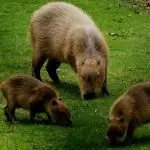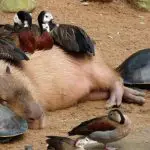Capybara vs Groundhog: Understanding the Differences Between Two Rodents
Despite similarities, capybaras, and groundhogs have significant differences between the two that are worth exploring. Understanding these differences will enhance your knowledge of these fascinating creatures, which may help you to manage wildlife.
So, how does a capybara differ from a groundhog? Capybaras are the largest rodents in the world, while groundhogs are relatively small. Capybaras are also semi-aquatic animals, while groundhogs are terrestrial creatures that burrow underground. Another significant difference is capybaras are native to South America, while groundhogs are found in North America.
This article will dig through these differences and provide a better understanding of the unique traits that make each species distinct. Also, this will provide you with a greater appreciation for the diversity of the animal kingdom.
Scientific Classification of Capybaras and Groundhogs
To understand where they genetically belong, understanding their scientific classification will help.
Scientific Classification of Capybara
- Common name: Capybara/ Greater capybara
- Scientific Name: Hydrochoerus hydrochaeris
- Kingdom: Animalia
- Phylum: Chordata
- Class: Mammalia
- Order: Rodentia
- Family: Caviidae
- Genus: Hydrochoerus
- Species: H. hydrochaeris

Scientific Classification of Groundhog
- Common name: Groundhog, Woodchuck, Chuck, Wood-shock, etc.
- Scientific Name: Marmota monax
- Kingdom: Animalia
- Phylum: Chordata
- Class: Mammalia
- Order: Rodentia
- Family: Sciuridae
- Genus: Marmota
- Species: M. monax

An Overview of Key Differences Between Capybaras and Groundhogs
The following table provides a quick and easy-to-read summary of the main differences between capybaras and groundhogs.
| Characteristics | Capybara | Groundhog |
|---|---|---|
| Size and Weight | Largest rodent; can weigh up to 140 lbs | Medium-sized rodent typically weighs 4-14 lbs |
| Coloration | Brownish-gray fur | Brown fur with a lighter underside |
| Habitat | Aquatic or semi-aquatic, found near water sources | Burrow-dwelling, found in open grasslands and woodlands |
| Diet | Herbivorous, eats mostly grasses and aquatic vegetation | Herbivorous, eats mostly plants, fruits, and vegetables |
| Social Behavior | Live in groups, highly social and interactive | Solitary or live in small family groups |
| Reproduction | Give birth to litters of up to 8 offspring, the gestation period of 130-150 days | Give birth to litters of 2-6 offspring, the gestation period of 32-44 days |
| Lifespan | 4-8 years in the wild, up to 12 years in captivity | Average 3 years in the wild, up to 14 years in captivity |
Capybara vs Groundhog: Physical Characteristics
Capybaras and groundhogs are two distinct rodent species with unique physical features. In this section, we will discuss the differences in size, weight, coloration, and other physical characteristics of these two animals.

Size and Weight
Capybaras are the largest rodents in the world, reaching up to 1.3 meters (4 feet) in length and weighing between 35 to 66 kilograms (77 to 146 pounds).
On the other hand, groundhogs, also known as woodchucks, are much smaller. They measure only up to 63 centimeters (2 feet) including tail in length and weigh around 3 to 6 kilograms (6 to 13 pounds).
Coloration
Capybaras have a short, dark brown, or reddish-brown coat, while groundhogs have a grizzled brown coat with lighter underparts. Both species have sharp claws and strong legs, which they use to dig burrows and defend themselves from predators.
Unique Physical Features
Capybaras have several unique physical features that set them apart from groundhogs. They have webbed feet. But they don’t have any tails. They can stay submerged underwater for up to five minutes. They also have eyes, ears, and nostrils located on the top of their heads, which allow them to see, hear, and smell while in the water.

Groundhogs, on the other hand, have large incisors that they use to gnaw on wood and other plant material. Also, they have a unique defense mechanism where they emit a loud, high-pitched whistle to warn other groundhogs of danger.
Capybara vs Groundhog: Habitat and Distribution
Understanding the habitat and distribution of these animals is crucial to understand their ecological roles in the ecosystem.
Capybara
- Distribution: Capybaras are native to South America, specifically in the tropical and subtropical regions of the continent. They’ve been introduced to other parts of the world, such as Central America and parts of North America, including Florida.
- Habitat: Capybaras prefer to live near bodies of water, such as rivers, swamps, and marshes. They are adaptable animals and can also live in forested areas and grasslands.
Groundhog
- Habitat: Groundhogs prefer to live in open fields and forest edges. They are also adaptable animals and can live in suburban and urban areas.
- Distribution: Groundhogs are native to North America, specifically in the eastern and central regions of the continent. Groundhogs have not been introduced to other parts of the world.

Capybara vs Groundhog: Behavior and Lifestyle
Capybaras and groundhogs have distinct behavior and lifestyles
1. Social Behavior
- Capybaras: Capybaras are highly social and live in groups that can range from a few individuals to more than 100. They have a complex social structure that includes dominance hierarchies, grooming behaviors, and communication through vocalizations and scent marking. Capybaras are generally peaceful animals.
- Groundhogs: Groundhogs are solitary animals that only come together during the mating season. They live in burrows and are known for their territorial behavior, often fighting with other groundhogs to defend their burrows.

2. Eating Habits
- Capybaras: Capybaras are herbivores and primarily feed on grasses and aquatic plants. They have unique feeding habits. They eat their poops which contain many beneficial bacteria. Bacteria’s digestive system allows them to extract nutrients from tough, fibrous plant materials.
- Groundhogs: Groundhogs are also herbivores and mainly feed on grasses, clover, and other plants. They have a special pouch in their cheeks that allows them to carry food back to their burrows.
3. Sleeping Patterns
- Capybaras: Capybaras are active during the day and sleep at night. They often rest in groups in areas near water where they can easily escape from predators.
- Groundhogs: Groundhogs are diurnal and sleep at night in their burrows. They hibernate during the winter months to conserve energy.
4. Other Lifestyle Factors
Capybaras
Capybaras are highly adaptable animals and can be found in a variety of habitats, including forests, grasslands, and wetlands. They are often hunted for leather and can be considered pests in some agricultural areas.
Groundhogs
Groundhogs are also adaptable and can be found in a variety of habitats, including fields, forests, and suburban areas. They are considered pests by some gardeners due to their burrowing behavior.

5. Comparing Verdict
Capybaras and groundhogs have different social structures, with capybaras living in groups and groundhogs being solitary. They also have different eating habits, with capybaras primarily feeding on grasses and aquatic plants, while groundhogs eat a wider variety of plants.
Capybara vs Groundhog: Ecological Importance
- Capybara: Capybaras are important grazers in their habitats, preferring to eat a variety of grasses and aquatic plants. Their grazing activities help maintain the vegetation in their environments, preventing overgrowth and promoting diversity.
Additionally, capybaras are considered keystone species, as they play a significant role in food webs and have a strong influence on the populations of other species in their ecosystem. They are also habitat engineers, influencing water resources and creating microhabitats that are beneficial to other animals and plants.

- Groundhogs: Groundhogs, on the other hand, are burrowing animals that have a significant impact on soil structure in their environments. Their burrows create habitats for other animals, providing shelter and protection from predators.
Groundhogs are also important seed dispersers, spreading seeds throughout their habitats and contributing to plant propagation. As prey species, they also influence predator populations and have a complex relationship with other herbivores in their environment.
While capybaras and groundhogs have different ecological roles, they are both important to the health and balance of their respective ecosystems. It is essential to preserve their habitats and populations to maintain the ecological integrity of their environments.
Capybara vs Groundhog: Mating, Reproduction, and Lifecycle
Capybaras and groundhogs have distinct reproductive behaviors and life cycles. Here are some of the key differences between the two species:
Mating Season
The capybaras mating season is year round with the peak reach in the middle of the year; May and June. This is the beginning of the rainy season. However, groundhogs mate in the early spring from early March to mid or late April.
Mating Ritual and Behavior
Capybaras are social animals and usually mate within their social groups. Groundhogs, on the other hand, are solitary animals that only come together for breeding purposes. However, both of these species are polygamous.

Gestation Period
Capybaras have a gestation period of around 150 days, while groundhogs have a shorter gestation period of around 32 days.
Litter Size
Capybaras can give birth to between one and eight offspring, while groundhogs typically have litters of two to six young.
Lifecycle Stage
Capybara young are born with their eyes open and can walk shortly after birth. They nurse for about 16 weeks and then start eating solid food.
Groundhog young are born blind, hairless, and helpless. They remain in the burrow for around 6-8 weeks before they begin to venure outside. They are weaned at around six weeks of age.
Lifespan
Capybaras can live up to 4-8 years in the wild, while groundhogs have a shorter lifespan of around 3 years in the wild.
If you’re interested in learning more about capybara care, you might also find our article on capybara care helpful. It provides valuable information on how to properly care for these fascinating animals, including their diet, habitat, social needs, and general well-being. Additionally, if you want to further explore the comparisons between capybaras and nutrias, you can check out our article on capybara vs. nutria, which highlights the similarities and differences between these two species.FAQs
Now, let’s explore some related questions about these rodent species.
Q: Can Capybara or Groundhogs be kept as pets?
Capybaras make pleasant household pets. However, before owning, you must consider some factors specially space, diet, veterinary care, and cost. But, groundhogs can’t be kept as pets as they dig and chew almost everything in their way.
Q: Are Capybaras endangered?
Capybaras are not currently classified as endangered. They are listed as a species of “least concern” by the International Union for Conservation of Nature (IUCN).
Q: Why do Groundhogs hibernate?
Groundhogs hibernate during the winter months. They typically enter hibernation in late fall and emerge in early spring. During hibernation, their heart rate and body temperature decrease significantly to conserve energy, and they rely on fat reserves to survive until spring.
Final Words
Capybaras and Groundhogs are both fascinating animals with unique characteristics and behaviors. While they are both classified as rodents, they have distinct physical differences, preferred habitats, social behaviors, and reproductive cycles.
Capybaras are native to South America and are the largest rodents in the world, while Groundhogs are found in North America and are known for their burrowing behavior. Despite their differences, both species play important ecological roles in their respective habitats, interacting with other animals and plants in complex ways.




